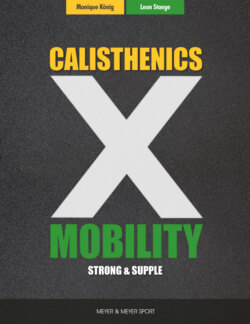Читать книгу Calisthenics X Mobility - Monique König - Страница 6
На сайте Литреса книга снята с продажи.
ОглавлениеPreface
Introduction: Book Layout
MOBILITY
What Motivates Me to Get You Moving
1 Mobility—Modern Flexibility Training
2 Understanding Mobility
2.1 How to Become More Mobile
2.2 The Reason We’re So Stiff
2.3 Don’t Mobilize Every Joint
2.4 Why Stretching and Yoga Won’t Make You More Mobile
2.5 Why Foam Rollers Won’t Make You More Mobile
2.5.1 The Foam-Roller Phenomenon
2.5.2 Rolling, Rolling, Rolling
2.5.3 Surface Sensibility versus Proprioceptive Sensibility
2.5.4 Pain While Rolling
2.5.5 Foam Rollers-Sense or Nonsense?
2.6 More Exercise Equipment You Don’t Need
2.7 How Mobility Makes You Stronger
2.8 Why Stress Makes You Immobile
3 Mobility Fundamentals: What You Need to Know
3.1 Four Easy Steps to Becoming More Mobile
3.1.1 Evaluation
3.1.2 Isolation
3.1.3 Integration
3.1.4 Improvisation
3.2 Pain and Injuries
3.2.1 Pain
3.2.2 Injuries
3.3 Guidelines for Pain-Free Training
4 The Most-Common Questions About Mobility
4.1 How Long Until I’m More Mobile?
4.2 How Can I Become More Mobile More Quickly?
4.3 How Do I Add Mobility to My Strength Training?
4.4 How Do I Integrate Mobility Into My Daily Life?
5 Mobility Lifestyle Hacks
6 Movement Is Life, and Life Is Movement
7 Mobility Exercises
7.1 Wrists
7.1.1 Wrist Figure Eights
7.1.2 Wrist Mobilization on the Ground
7.1.3 Backhand Push-ups
7.1.4 Shaolin Push-ups
7.1.5 Wrist Push-ups
7.2 Spine
7.2.1 Spinal Rotations (CARs)
7.2.2 Spinal Wave 1
7.2.3 Spinal Wave 2
7.2.4 Neck Mobilization
7.2.5 Three-Point Thoracic-Spine Rotation
7.2.6 All-Fours Rotation
7.2.7 Ball
7.2.8 Prone Thoracic-Spine Rotation
7.2.9 Wrestler Rotation
7.2.10 Table Rotation
7.2.11 Heel-Sitting Rotation
7.2.12 Cross-Legged Rotation
7.2.13 Cobra
7.3 Shoulders
7.3.1 Shoulder Rotations (CARs)
7.3.2 Shoulder Rotations Against the Wall
7.3.3 Hanging
7.3.4 Single-Arm Hanging
7.3.5 Wall Slides
7.3.6 Shoulder Crawl
7.3.7 Swimmer
7.3.8 Protraction and Retraction Drill
7.3.9 Shoulder Dislocator With a Band
7.3.10 Shoulder Rotation With a Band
7.3.11 Side Bend
7.3.12 Skin the Cat (Regression)
7.3.13 Skin the Cat
7.3.14 Scapula Push-up Rotation
7.3.15 Arched-Back Pulls
CALISTHENICS
8 My Path to the Pull-up Bar
9 Calisthenics
9.1 Roots of Calisthenics
9.2 The Rain-or-Shine Training Mentality
9.3 The Four Types of Calisthenics
9.4 From Trend Sport to Business: Calisthenics in Germany
9.5 Calisthenics versus CrossFit versus Freeletics
9.6 Why Everyone Benefits From Bodyweight Training
9.7 Your Prerequisites
9.8 Useful Equipment
9.9 Calisthenics Parks: The Best Spots for Your Training
9.10 Guidelines for Ambitious Calisthenics Beginners
9.11 Ditching Familiar Movement Patterns: Embracing the Unusual
9.12 Exertion to the Point of Exhaustion: The 80-Percent Rule
9.13 Setting Goals the Right Way
10 Calisthenics Fundamentals: What You Need to Know
10.1 Overview of Basic Exercises
10.2 Balancing Stability and Mobility
10.3 Movement Variations
10.4 Movement Specifics
10.5 Assistance Exercises
10.6 Difficult Exercises Made Easy
10.7 Sticking Points
10.8 Full Range of Motion
10.9 Shoulder-Blade Positions
10.10 A Firm Grip
10.11 Hollow-Body Position
10.12 All About Levers
10.13 Repetition: The Mother of Skill
10.14 Straight-Arm Strength
10.15 Training on Rings
10.16 Calisthenics and Leg Training
10.17 Shoulder Joint
11 Beginner Basics and Their Possible Progressions
11.1 Healthy Shoulder Balance With a Combination of Pulling and Pushing Loads
11.2 Activation Exercises
11.3 Pull-ups and Possible Progressions
11.3.1 What Your Pull-up Should Look Like
11.3.2 Typical Mistakes
11.3.3 Frequent Sticking Points
11.3.4 Grip Variations
11.3.5 Overhand Pull-ups versus Underhand Pull-ups
11.3.6 Arched-Back Pull-ups
11.3.7 Pull-up Exercise Regressions
11.4 Push-ups and Possible Progressions
11.4.1 What Your Push-up Should Look Like
11.4.2 Typical Mistakes
11.4.3 Frequent Sticking Points
11.4.4 Grip Variations
11.4.5 Push-up Exercise Regressions
11.5 Dips and Possible Progressions
11.5.1 What Your Dip Should Look Like
11.5.2 Typical Mistakes
11.5.3 Frequent Sticking Points
11.5.4 Dip Exercise Regressions
11.6 Squats and Possible Progressions
11.6.1 What Your Squat Should Look Like
11.7 Regression: The L-Sit
11.7.1 Hanging L-Sit
11.7.2 L-Sit in a Support Position (Arms)
11.7.3 Assisting Exercises
11.8 Rehabilitation and Prehabilitation Exercises
12 General Training Structure
12.1 Training Methods
12.1.1 Frequency of Training, Number of Sets, Number of Repetitions, and Breaks
12.1.2 Types of Training
13 Goals, Time Investment, and Motivation
14 Acknowledgments
15 The Authors
16 Appendix
1Glossary
2Further References
3Credits
